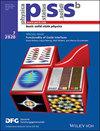Bismuth Ordering and Optical Anisotropy in GaAsBi Alloys
IF 1.8
4区 物理与天体物理
Q3 PHYSICS, CONDENSED MATTER
引用次数: 0
Abstract
Reflectance anisotropy spectroscopy (RAS) is applied to investigate GaAsBi samples grown by molecular beam epitaxy on (001)‐oriented GaAs substrates with GaAs or InGaAs buffer layers, resulting in nearly lattice‐matched or compressive strain conditions, with Bi concentration in the alloy in the range 2–5%. These new samples allow to bridge the gap in the Bi concentration values of previous RAS experiments (C. Goletti et al.,砷化镓铋合金中的铋有序性和光学各向异性
反射各向异性光谱 (RAS) 被应用于研究通过分子束外延在带有 GaAs 或 InGaAs 缓冲层的 (001) 方向 GaAs 基底上生长的 GaAsBi 样品,其结果是在几乎晶格匹配或压缩应变的条件下,合金中的铋浓度在 2-5% 的范围内。这些新样品弥补了之前 RAS 实验(C. Goletti 等人,Appl. Phys. Lett.利用 X 射线衍射和透射电子显微镜对生长的砷化镓铋样品进行的表征清楚地证明了块体中存在类铜铂有序结构。由于块体晶格中产生的各向异性应变,CuPt 结构是通过 RAS 和偏振光发光测量到的光学各向异性的主要来源。3 eV 以上的 RAS 光谱线形及其整体和特有的正凸性证实了这一结论。
本文章由计算机程序翻译,如有差异,请以英文原文为准。
求助全文
约1分钟内获得全文
求助全文
来源期刊
CiteScore
3.30
自引率
6.20%
发文量
321
审稿时长
2 months
期刊介绍:
physica status solidi is devoted to the thorough peer review and the rapid publication of new and important results in all fields of solid state and materials physics, from basic science to applications and devices. Being among the largest and most important international publications, the pss journals publish review articles, letters and original work as well as special issues and conference contributions.
physica status solidi b – basic solid state physics is devoted to topics such as theoretical and experimental investigations of the atomistic and electronic structure of solids in general, phase transitions, electronic and optical properties of low-dimensional, nano-scale, strongly correlated, or disordered systems, superconductivity, magnetism, ferroelectricity etc.

 求助内容:
求助内容: 应助结果提醒方式:
应助结果提醒方式:


